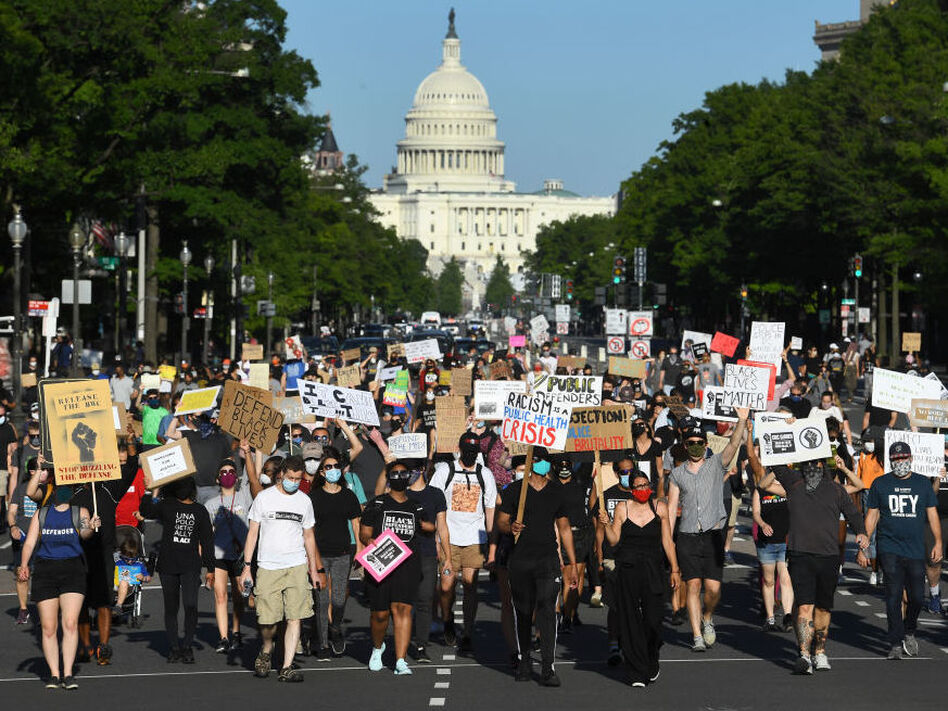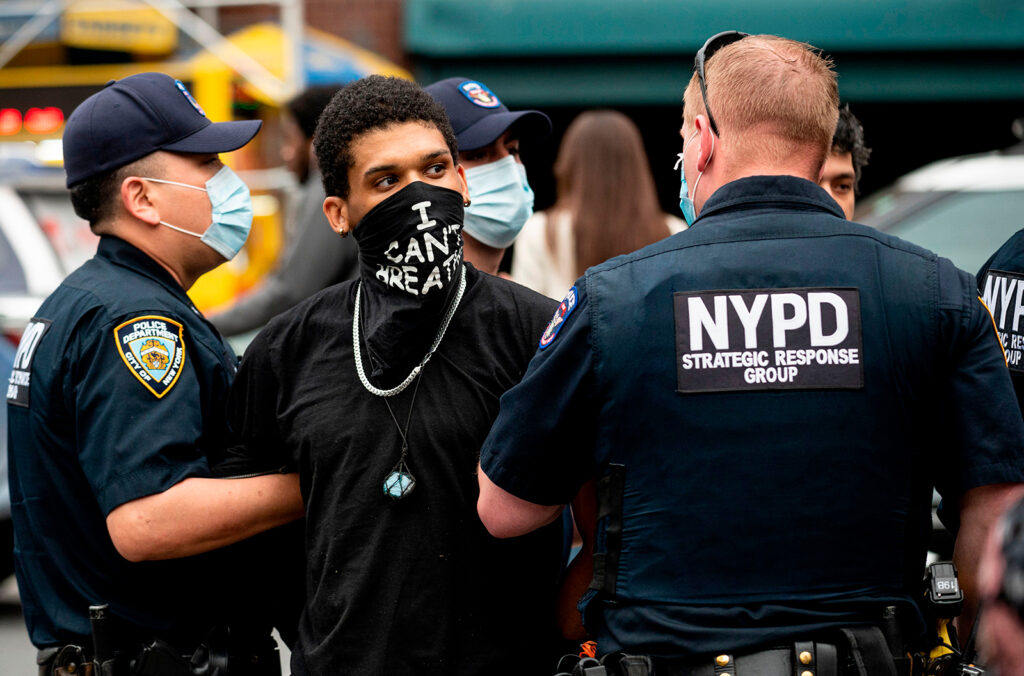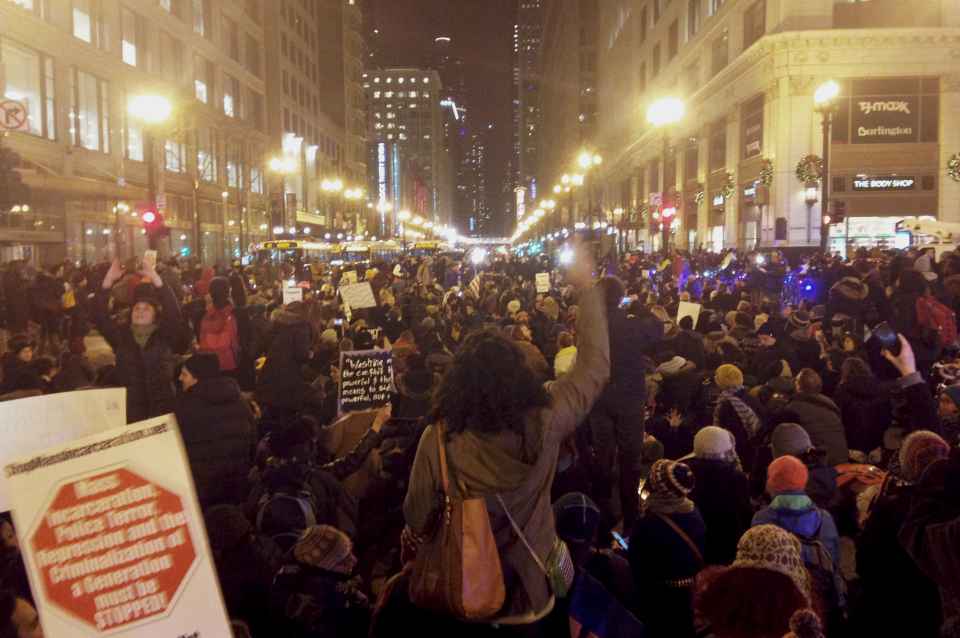Here are ways to protect yourself and others before pulling out a camera and posting to social media.

With leaked documents suggesting Roe v. Wade may be overturned by the US Supreme Court later this year, protests in support of reproductive rights are being organized around the country. Portions of Justice Samuel Alito’s preliminary opinion could significantly shrink the rights guaranteed to American citizens, with openings for the future criminalization of contraception and nullification of same-sex as well as interracial marriages on a state-by-state basis.
If you’re going to head out to protest these and other injustices, and take photos while you do so—as is your First Amendment right—there are some things you should keep in mind. Whether you’re using a smartphone or a DSLR, documenting a protest with photos and video can be an important part of telling the story of what happened and when. But those photos can also be used to harm you or your fellow protesters.
Here are some steps you should take to keep yourself and others safe.
- Be Sure Of Your Why
- Have a Plan and Go with a Friend
- Photography Tips
- Posting Photos On Social Media Safely
- Necessary Gear to Bring
Be Sure Of Your Why
Before you grab your camera and rush out the door, ask yourself why you want to take photos at this event. You should not take photos at a protest for likes, follows, or social media clout. Do not attend a protest just to say you were there. Protests aren’t photoed shoots, and the people in the streets venting their anger and frustration at systemic injustices aren’t there to pose for your Insta. Just think about your motivations, and be honest with yourself.
Would you still want to protest if you left your phone and camera at home? Be a protester first, a photographer second.
Have a Plan and Go with a Friend
More specifically though, protest with a couple of friends, relatives, or roommates. Stick together, share supplies, and look out for each other. Going to a protest with even just one other person can take a lot of the stress out of it. Your friend can watch your back while you take photos and make sure you’re not standing in anyone’s way.
If police declare an unlawful assembly and start using force to disperse crowds, it can be really hard to find a reliable way home. Rideshare services like Lyft or Uber might not be able to pick you up. The same goes for mass transit; buses and trains might be shut down or rerouted around protest routes.
The easiest plan is the simplest one: Plan on walking. You don’t need to walk all the way home, but be prepared to walk a good quarter-mile before you find a bus, train, or rideshare driver willing to pick you up. If you can, ask a friend who won’t be at the protest if they can be available to come to pick you up. Last resort, check social media. Search under local hashtags for organisations offering rides or retweeting people who are protesting. Stick with trusted organizations, though; don’t let a stranger come pick you up.
You may also want to consider what you might do if you witness violence. I can’t answer this one for you. Sometimes the best thing you can do is take photos or shoot a video. Images have power. But there may also be a time to put the camera away and act. This is an important question to ask yourself before you head out the door.
Photography Tips
Protests can grow quickly, so even if you think you’re attending a small protest or march it’s important to take your role seriously and avoid putting yourself or anyone else in harm’s way.
- Don’t use a viewfinder: Bringing a camera to your eye can limit your field of view, and it’s easy to get tunnel vision when you’re composing a photo. If your camera can do it, try to take photos using the rear display so you can keep your peripheral vision.
- Do not act abruptly (stay vigilant): This is for your safety and for the safety of other people. Don’t suddenly stop to take a photo. Look around, step out of the way, aim, and snap.
- Do not stop in front of people: Dropping to a knee for a great shot isn’t worth it if you’re just going to trip someone or get yourself trampled.
- Do not get in anyone’s face: Be respectful. Ask if you can take a photo before you do, especially if you’re close to your subject. Some people are risking their jobs by showing up at protests. Even if they’re wearing a mask, employers can still identify them. Remember, you’re there to protest first, and take photos second.
- Avoid photographing faces and tattoos: You also have an obligation to keep others safe. Don’t take pictures that would make it easy to identify someone.
- Do not post to social media without thorough editing: We’ll get to this step next. You must keep in mind that your photos and videos can be used to harm your fellow protesters.
Posting Photos On Social Media Safely

Don’t post your photos or videos without taking a good hard look at them. Whether you’re editing them on your phone or in Lightroom, protest photos require some special handling and extra care.
Be sure to remove identifying features and faces from protesters in your photos. Don’t just use the blur tool; etch them out with black. If you use a face blurring app on your phone, be careful. Make sure that the app does all its processing on your phone and doesn’t save copies of the unedited files or upload them to the cloud for processing. You could use Image Scrubber for eliminating metadata and blurring faces. It processes images in the browser window and works on Windows, macOS, iOS, and Android.
Take pains to avoid sharing your location, too. By default, your camera apps will save location data. You can turn this off in your camera settings, but you should do more. If you aren’t using a tool like an Image Scrubber to eliminate location metadata, don’t post your photos to social media at all. Post screenshots of your photos so there’s no location data in the image file. On a smartphone or tablet, it’s easy to just snap a screenshot and crop out the UI. On a PC use the Snipping Tool. On macOS hit Cmd+Shift+4.
Be careful about posting photos while the protest is still going on because it may let people know where you’re at. Photos and video can be used to track the movements of protests. Disable location services for Twitter, Facebook, Instagram, or any app you’re going to upload from. If you post the next day, you have less to worry about.
Necessary Gear to Bring
Whether you own a dedicated camera or plan to use your smartphone, here are some tips on what to bring.
If you’re planning on taking a camera, leave the long lenses at home. Stick with something compact and lightweight, like a short zoom or small prime lens. My personal favourite for protests is a Fujifilm X-Pro 2 with a 23-mm prime lens. It’s a small camera with a small-ish lens, but most mirrorless cameras with the right lens (think 35-mm or 50-mm) would be a great choice.
- Don’t bring a tripod, collapsible monopod, or any gear that could be mistaken for, or used as, a weapon.
- Bring one lens and one camera body. Switching lenses or camera bodies in the middle of a protest is a recipe for disaster. Stick with short zooms and prime lenses.
- Don’t bring a big camera bag full of gear. Save bag space for water bottles and other supplies. Bring a couple of memory cards and batteries, that’s all you need.
- Bring a secure strap and sling it around your neck, not your body. Maintain as small a profile as you can so you’re not jostling against people in the crowd.
- If your camera has two memory card slots, set it up for redundancy, so you have two copies of all your photos—just in case.
… If You’re Using a Smartphone Camera
Most phones are more than capable of taking beautiful photos, but they require extra consideration because they also contain almost all of your personal information.
Check these guides on how to secure your privacy and personal data while at a protest.
- Use a case and screen protector on your phone. Bring a backup charger and battery pack.
- Turn off FaceID or fingerprint unlock. Use a code to lock your phone.
- Open the camera from the lock screen. Don’t unlock your phone to take photos. This keeps your phone locked and secure in case it’s confiscated, dropped, or stolen.
- These phone camera accessories can turn your phone into a camera that can rival some mirrorless cameras.
- Consider using two cameras. Using your phone in conjunction with a traditional DSLR or mirrorless camera will give you the best of both worlds. Most smartphones have a wide-angle lens, so you can equip your high-end camera for up-close photos and portraits.





